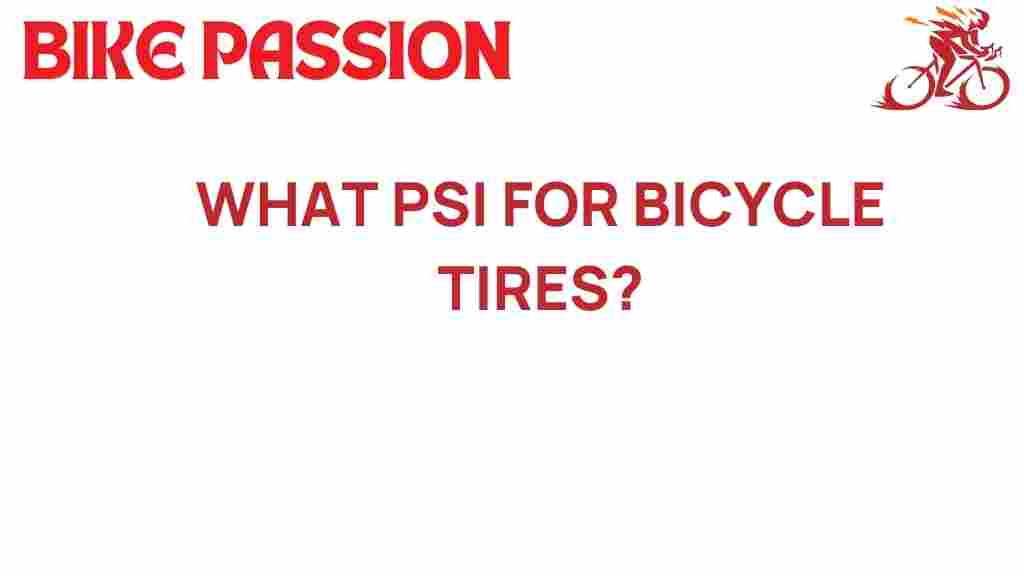Unraveling the Mystery: What PSI for Bicycle Tires is Ideal?
When it comes to cycling, one of the most crucial yet often overlooked aspects is tire pressure. Understanding the right PSI (pounds per square inch) for bicycle tires can significantly impact your overall cycling performance, ride comfort, and safety. In this comprehensive guide, we will explore the ideal tire pressure, factors influencing optimal pressure, and essential tire maintenance tips to enhance your cycling experience.
Why PSI Matters for Bicycle Tires
PSI is a measurement of air pressure within your bicycle tires. The correct PSI ensures that your tires perform at their best, providing the right balance between grip, comfort, and efficiency. Here are a few reasons why maintaining the optimal pressure is vital:
- Safety: Under-inflated tires can lead to blowouts or loss of control, while over-inflated tires can reduce traction.
- Ride Comfort: Properly inflated tires absorb shocks better, providing a smoother ride over rough terrain.
- Cycling Performance: The right PSI helps improve rolling resistance, enabling you to ride faster with less effort.
Determining the Optimal Pressure for Your Bicycle Tires
Finding the optimal pressure for your bicycle tires involves several factors, including the type of bike you own, the terrain you ride on, and your body weight. Here’s a step-by-step process to help you determine the best PSI for your needs:
Step 1: Check Manufacturer Recommendations
The easiest way to find the optimal pressure is to check the sidewall of your tires. You’ll often find a range of recommended PSI values printed there. Most road bike tires recommend a PSI between 80 to 130, while mountain bike tires generally suggest 30 to 50 PSI.
Step 2: Consider Your Weight
Your body weight plays a crucial role in tire pressure. Heavier riders may need to inflate their tires towards the higher end of the recommended PSI range, while lighter riders can opt for lower pressures. A good rule of thumb is to adjust your tire pressure by 1 PSI for every 10 pounds of body weight.
Step 3: Evaluate Your Riding Style
Your riding style also influences the ideal PSI. If you frequently ride on rough terrain or off-road, you may benefit from lower pressure for increased traction and comfort. Conversely, if you’re a competitive road cyclist, a higher PSI will reduce rolling resistance and improve speed.
Step 4: Test and Adjust
After setting your initial tire pressure, take your bike for a short ride. Pay attention to how the tires feel. If you notice excessive bounce or harshness, lower the PSI slightly. If the ride feels sluggish or unresponsive, consider increasing the pressure. Fine-tuning your PSI can lead to a more enjoyable cycling experience.
Inflation Tips for Bicycle Tires
Maintaining the correct PSI requires regular checks and proper inflation techniques. Here are some tips to help you keep your tires in optimal condition:
- Check Pressure Regularly: Use a reliable pressure gauge to check your tire PSI at least once a month. Tires can lose air over time, and regular checks ensure you maintain the right pressure.
- Use a Floor Pump: Invest in a good quality floor pump with a pressure gauge for easy inflation. Floor pumps are more efficient than hand pumps and often provide more accurate readings.
- Inflate Before Long Rides: Always check and inflate your tires before embarking on long rides. This helps prevent flat tires and ensures a smooth experience.
- Warm Up Your Tires: Remember that tire pressure can increase as you ride due to heat. If you’re inflating tires right before a ride, consider inflating them a few PSI below the recommended range to account for this increase.
Troubleshooting Tire Pressure Issues
Sometimes, despite your best efforts, you may encounter issues with tire pressure. Here are some common problems and solutions:
Problem 1: Frequent Flat Tires
If you find yourself getting flat tires often, check the following:
- Tire Condition: Inspect your tires for any visible damage, punctures, or worn spots.
- Rim Tape: Ensure that the rim tape is properly installed and intact to prevent punctures from the spokes.
- Pressure Levels: Make sure you’re not over-inflating or under-inflating the tires.
Problem 2: Tires Feel Too Bouncy
If your ride feels excessively bouncy, your tires may be over-inflated. Try lowering the PSI gradually until you find a more comfortable ride.
Problem 3: Poor Handling
If your bike feels unresponsive or difficult to handle, check your tire pressure. Under-inflated tires can cause sluggish handling and increase the risk of pinch flats. Adjust the PSI to match your riding style and terrain.
The Importance of Tire Maintenance
Regular tire maintenance not only helps ensure optimal pressure but also extends the lifespan of your tires. Here are some essential maintenance tips:
- Inspect Tires for Damage: Regularly check for cuts, punctures, or uneven wear. Replace any damaged tires promptly.
- Clean Tires: Keep your tires clean from debris, dirt, and mud, especially after riding on rough terrains.
- Rotate Tires: If you have a bike with interchangeable tires, consider rotating them to promote even wear.
Conclusion
Understanding the ideal PSI for your bicycle tires is essential for maximizing your cycling performance, ensuring ride comfort, and maintaining safety. By following the steps outlined in this guide, you can easily determine the optimal pressure for your needs and keep your tires in excellent condition. Remember, regular checks and proper inflation techniques are key to enjoying a safe and pleasant cycling experience.
For more comprehensive tips on cycling maintenance, check out our article on Essential Bicycle Maintenance Tips. And for the latest in cycling gear and accessories, visit BikeRadar.
This article is in the category Gear and created by BikePassion Team
